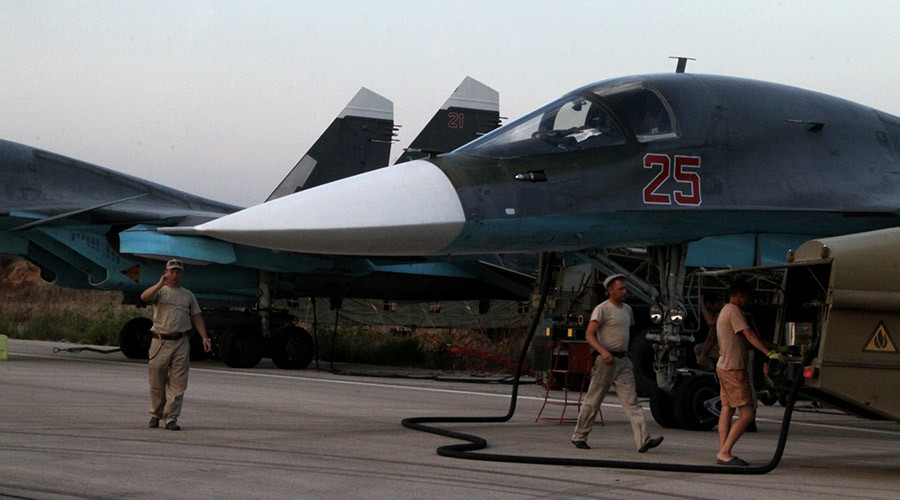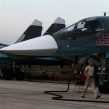
Russia Initiates ‘Out-of-Area Operation’ In Syria
Publication: Eurasia Daily Monitor Volume: 12 Issue: 180
By:

As Russia’s military build-up in Syria moved forward, President Vladimir Putin addressed the 70th meeting of the United Nations General Assembly and held bilateral talks with President Barack Obama. On September 30, Putin received authority from the Russian Federation Council to send his forces into action and consequently ordered the Russian Federation’s first “out-of-area operation” (that is, outside the former Soviet Union) to commence. Russian airstrikes in support of the Syrian regime prepare the way for an offensive involving ground forces from Syria, Iran and Hezbollah. The nature of the Russian force grouping, its deployment and early use against a variety of targets affords insight into how the Kremlin’s strategy is unfolding. Further clues as to how this will develop were in evidence during the strategic-operational military exercise Tsentr 2015 (see EDM, September 22), while the role of Russian military intelligence will be a critical element in targeting and in determining the future shape of the campaign (RIA Novosti, September 30).
During a three-week period, Moscow ordered the deployment to Latakia of a regiment sized force grouping from the Air Force component of the newly created Aerospace Forces (Vozdushno Kosmicheskikh Sil—VKS). These air movements occurred under the cover of the Tsentr 2015 exercise, and they mixed squadrons of Su-24Ms and Su-25SMs (ground attack) with multi-role Su-30SMs and Su-34s, as well as Mi-8s and Mi-24 attack helicopters. On September 18, for instance, four Su-30SMs were transferred from their base in Domna (Chita) to Mozdok, and then accompanied by a heavy transporter, which flew through the airspace of Azerbaijan, Iran and Iraq before reaching Latakia. In late September, six Su-34s arrived via the Caspian Sea, Iran and Iraq, completing the first stage of the military build-up, which was accompanied by sending sophisticated surface-to-air missiles (SAM) and a battalion of Naval Infantry for base protection. The force grouping mixes tried-and-tested platforms such as Su-24Ms and Su-25SMs with state-of-the-art Su-34s. According to the defense ministry, the latter will offer increased precision strike capability, but these platforms will also likely be tested during forthcoming operations (Armstrade.org, October 1).
In Tsentr 2015, the VKS assembled an aviation grouping of 150 bombers and fighter aircraft, which was singled out for praise by Defense Minister Sergei Shoigu (Mil.ru, September 29; see EDM, September 22). It contained a significantly different force mix and operated on a massive scale. Su-24s and Su-25s were used to attack enemy command and control, and to disable artillery firing positions. Su-27s cleared the airspace of enemy aircraft ahead of the arrival Tu-22M3 strategic bombers to attack various outposts. Mi-35 attack helicopters were involved in preparing the insertion of Ground Forces, followed by wave attacks from Su-34s. The rehearsed air campaign relied heavily on precision strike and reconnaissance supplied by unmanned aerial vehicles (UAV). The Russian air campaign in the exercise also featured automated command and control, and practiced closely integrating ground offensives with close air support. The coup de grace in the exercise was administered by Tu-22M3s flying sorties against “illegal armed groups” and supply depots, such as ammunition dumps (Krasnaya Zvezda, October 1). Based upon VKS activities during Tsentr 2015 and defense ministry claims of a coming intensification of the air operations in Syria, it is likely the worst of the airstrikes against a wide range of “terrorist” targets in Syria still lies ahead.
Indeed, early reports of the targeting in the Russian airstrikes seemed to indicate that under the umbrella of going after Islamic State (IS) and “terrorist groups,” the VKS targets other rebel groupings. This makes sense from Moscow’s perspective, as the air campaign seems designed to degrade opposition forces and de facto strengthen the Syrian regime. These operations relied on using Su-24Ms and Su-25SMs in classical Soviet/Russian airpower operations seen in Afghanistan, Chechnya and Georgia. Of course, some differences are also apparent, such as the experimentation with precision-guided munitions (PGM), including BetAB-500 bunker buster bombs delivered by Su-34s (Nezavisimoye Voyennoye Obozreniye, October 4).
Although the groups targeted by the Russian air campaign is wider than an anti-IS operation, the exact requirements of target selection seems guided by Russian military intelligence (Glavnoye Razvedyvatel’noye Upravleniye—GRU), relying heavily upon reconnaissance gathered from extensive use of UAVs. The intelligence coordination center opened in Baghdad brings together Russia, Syria, Iran and Iraq, but remains in its infancy; Moscow would be reluctant to rely solely on intelligence offered by its coalition partners. Indeed, it is inconceivable that the Russian military would engage in operations without extensive preparation of the battlefield and accompanied by GRU “eyes and ears” on the ground (Moskovskiy Komsomolets, October 1).
On October 4, Su-24s and Su-34s attacked targets using precision-guided Kh-29L missiles. The various Russian platforms in use over Syria have also used a mixture of PGMs, cluster bombs and dumb bombs: these include the FAB-250 and FAB-500. Some sources suggest the Air Force will also use FAB-1000 and FAB-1500 bombs. Russian airpower specialists suggest that this early phase of the air campaign is only a rehearsal for its later stages (Nezavisimoye Voyennoye Obozreniye, October 4; Moskovskiy Komsomolets, October 2).
Putin’s intervention in Syria does not rely solely upon airpower. One key aspect of this early phase of the operation is to prepare the battlefield for the ground offensive that will be launched by Syrian and Iranian military units alongside Hezbollah; it is also likely to include other proxies such as “volunteers” drawn to the conflict. The ground forces element is the main difference between the Russian spearheaded coalition and its Western counterpart, and although open to question as to its success, it will certainly change the situation on the ground. It is likely that the Russian air campaign will go through an evolutionary process, changing according to battle damage assessments (BDA) and following ground offensives. The Russian military media offers various estimations of the timescale of the air operation, at around three or four months, but this seems optimistic. The Kremlin clearly wants to greatly degrade the rebel opposition to President Bashar al Assad’s regime, perhaps as a precursor to a wider ground offensive in territories held by the Islamic State (Vedomosti, October 1, 3; Nezavisimoye Voyennoye Obozreniye, September 30).
While experts and commentators debate Putin’s motives for authorizing the Russian military operation, two points must surely concentrate the minds of policy planners in the United States and the North Atlantic Treaty Organization (NATO): First, Putin forged a diplomatic-military coalition under the noses of the anti-IS coalition, deployed military assets, and caught Western governments by surprise—again. And second, the Russian leader has shown a willingness to risk confrontation with the US, first in Crimea and now in Syria.




